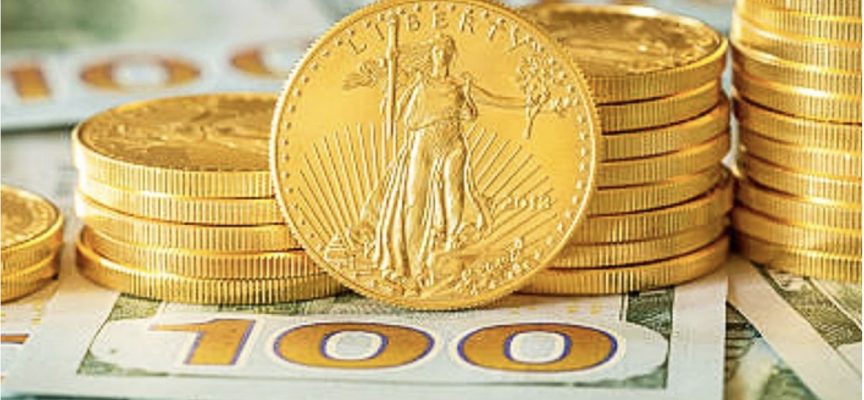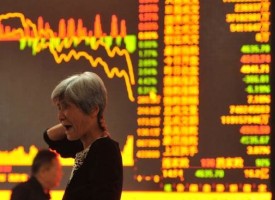Last time this happened gold rocketed. Market liquidity now approaching March 2020 collapse lows.
Gold, Steady in its Purpose
June 6 (King World News) – Michael Wong, Chief Investment Senior Portfolio Manager at Sprott Asset Management: May brought a continuation of April showers to the precious metals complex and many other asset categories. Gold bullion lost ground and is up 0.45% YTD through May 31, 2022, while silver bullion has declined 7.54% YTD. Gold mining equities were hard hit in May but remain 2.33% higher YTD. This compares to a YTD decline of 13.30% for the S&P 500 Index and a historic drawdown for bond markets which have lost 8.33% YTD, as measured by the U.S. Treasury Index.
Few May Flowers
Gold declined $59.58/oz (or -3.14%) in May to close the month at $1,837.35. May saw a continuation of April, with an across-the-board reduction in exposure to most asset classes. Liquidity and market depth deteriorated further while the Federal Reserve (“Fed”) maintained its hawkish rhetoric, and growth indications slowed further. The Russia-Ukraine war continued to show no resolution, but its effect on commodities, especially energy and grain supplies, worsened. Brent oil closed at $122.84 a barrel, only 4.0% off its February price spike high of $127.98. U.S. natural gas prices reached 14-year highs, while gasoline and diesel prices posted record highs. The Bloomberg Grains Subindex has surpassed its February highs and is likely to climb higher as many countries have already announced export bans (food security) and Ukrainian ports remain closed.
By mid-month, the S&P 500 Index came close to realizing a 20% drawdown, a common reference point for defining a bear market. Risk assets had another down leg as more evidence of a burgeoning economic slowdown grew. Some prominent retailers, known for their size, scale, and expertise in supply chain logistics and cost management, significantly missed earnings and guided to full-year declines. The miss was due to supply chain costs and inflation pressures, all indicative of consumer vulnerability. By month-end, as has been typical lately following a violent selling leg, downside protection was monetized, resulting in dealer deltas becoming less negative and the upward squeeze (rapid prize changes that fuel rapid buying activity) began. The rapid deterioration of market depth or trading liquidity has exacerbated price movements in virtually every asset class.
Gold Bullion: Ahead of Other Asset Classes
May saw selling across most asset classes and fund types but not in a “crisis environment” manner. Although selling may have been despondent, it was not panicky. May’s grinding degrossing left little to no appetite for safe-haven assets such as gold. With volatility elevated across most asset classes, we will likely witness more VaR-related selling ahead, but the selling is likely to occur increasingly into a price vacuum (a buyers strike).
Market liquidity was horrible in May. Cross-asset and intra-stock correlations rose, realized volatility increased, the U.S. dollar (USD) broke higher, financial conditions tightened, etc., which led to widespread selling and deleveraging. However, there were no signs of a scramble for downside protection or safe haven assets. Volatility markets, credit spreads, credit default swaps, interest rate swaps, etc., were all elevated but not spiking, indicating the lack of an immediate threat to the financial system. In short, gold bullion rose and fell with overall market exposures in the absence of a crisis/panic. The glass-half-full view is that gold has outperformed most other asset classes (some by quite a bit); the glass-half-empty view is that gold did not materially increase. One’s perspective will depend on the type of investment portfolio one manages. However, market conditions remain vulnerable to panic if something were to break. As Figure 1 shows, gold continues to hold its uptrend in a “bending but not breaking” manner, despite many attempts to break lower.
Gold Does its Job
As measured by the S&P 500, equity markets had reached an all-time closing high on the first trading day of this year, January 3, 2022. Since then, the sell-off has impacted many asset classes. Figure 2 highlights some popular market segments with year-to-date (YTD) returns, their correlations to S&P 500 and realized volatility. Gold bullion held its value with the lowest correlation to the S&P 500 and the second-lowest realized volatility. Commodities have been the significant outperforming asset class year to date, but much of this performance was driven by supply shock effects on the energy commodity complex wrought by the Russia-Ukraine war.
Market Depth and Liquidity is Fading
Although markets may have been in a despondent mood, oddly, they have not been panicky. May saw many alternating one-day wonder rallies and one-day shock drawdowns caused mainly by the interplay of options hedging dynamics triggering buy/sell squeezes. Despite the significant drawdowns across most asset classes and the elevated volatility, there were no classic signs of panic or capitulation. Volatility markets, credit default swaps, credit spreads, etc., were all elevated but did not reach a state of stress or alarm, and with few signs of contagion effects.
One factor aiding the wild daily price swings has been the lack of market depth or trading liquidity. Figure 3 highlights our proxy for market depth, which is comprised of an amalgamation of depth indicators for equity futures, Treasury liquidity, credit and currencies. By this measure, market depth is approaching the nadir of March 2020, when the financial system seized up and forced central banks to unleash the most extraordinary liquidity injection. We also overlaid the S&P 500 Index/Gold Spot Price ratio (blue line) to highlight the general relationship between market depth and safe haven flight. As market depth deteriorates, gold tends to outperform equities.
Another event that is likely to reduce market depth further is QT (quantitative tightening), which is scheduled to start on June 1 at $47.5 billion per month ($30 billion in Treasuries, $17.5 billion in mortgage backed securities) for the first three months. By September, QT is slated to rise to $95 billion per month. If the function of QE (quantitative easing) was to “lower borrowing costs, boost spending, support economic growth, and ultimately increase inflation,” then QT is likely to have the opposite effect. We believe an underappreciated risk is QT’s effect on worsening market depth, increasing volatility, market dysfunction, and fragility, which are likely to support gold.
Don’t Fight the Fed
For the Fed, the stock market has become less critical than a disorderly increase in yields, credit spreads or the USD, all factors that would worsen Treasury market functioning. Higher equity markets are likely to translate to lower financial conditions, the antithesis of the Fed’s stated goal of tightening financial conditions to reduce demand pressures. Being bullish has become essentially fighting the Fed, and instead of a put, the Fed is writing calls.
The Fed is blatantly pursuing demand destruction via the negative wealth effect. The primary tools used since the GFC (global financial crisis) to inflate asset prices and create demand have now reversed. Low rates, dovish forward guidance, QE and low volatility have all flipped over to higher rates, hawkishness, QT and higher volatility to deflate asset prices and lower demand. Though the probability of an economic recession is uncertain, the chances of a profit recession are much higher. A profit recession has not been priced in yet and would result in another derate in price-earnings (P/E) levels. During the last four recessions, the average decline in earnings was about 20% from peak to trough.
This year’s market sell-off has been primarily a derating event and has not been earnings-driven yet, given earnings are still climbing. The derating process started with expensive stocks, mega-cap stocks and long-duration stocks, especially in the market’s speculative corners. The selling waves were in a rolling bear market that crushed mispriced duration assets. As real yields increased and financial conditions tightened, selling pressures have broadened to all market members.
Another level of support missing that investors have become dependent on since the GFC is the “market puts,” of which there are three types. The most prominent one is the Fed put, now suspended or at a much lower strike price. The second is the retail, buy-the-dip put, which has now retrenched after the tremendous losses in the speculative areas of the market. The third is the bond equity diversification (negative correlation) put, which is now gone…
Billionaire Eric Sprott is a big investor in this remarkable silver company click here or on the image below

Is Peak Inflation Transitory?
Everyone is looking for signs of peak inflation that may cause the Fed to relent, allowing risk assets to find a footing. Challenging this quest for signs of peak inflation are surging energy and food prices and tight labor and housing markets. Energy supplies and inventories are far too low, and with further sanctions placed on Russian energy, they are likely to deteriorate further. The Russia-Ukraine war is threatening wheat supplies and fertilizer exports. The largest fertilizer category by size is nitrogen-based fertilizer and the feedstock is natural gas, which is in short supply globally. Due to Russia (one of the largest oil and natural gas exporters) and Ukraine (major wheat and fertilizer exporter), food and energy prices have become more intertwined than at any other point in history.
More countries have announced export restrictions on grains in response to food security, limiting supply and threatening higher prices. Labor markets remain in acute shortage, the tightest in generations and there is mounting evidence of wage spiral effects. With record home prices, low inventories and a record number of building permits, housing remains a seller’s market. Though there are early signs that housing pressures may be easing, the situation remains tight and inflationary.
Cryptocurrencies’ Speculative Wild Ride
Once again, the recent behavior of gold versus cryptocurrencies strengthens the case that these assets fulfill contrary functions: safe haven store of value versus speculative trading vehicle.
At its peak, cryptocurrencies had a top market capitalization of ~$3 trillion and have now fallen to $1.31 trillion, a loss of ~$1.7 trillion or -56%. Cryptocurrencies have been volatile and, therefore, speculative. Cryptos had peaked out last November (2021), but the lastest downdraft was attributed to a collapse in stablecoins (cryptocurrencies pegged to a currency) segment of the crypto-ecosystem, essentially the crypto/DeFi version of “breaking the buck.” Contagion effects are always a concern, but in this case, they are likely to be limited due to the lack of counterparty exposures. Spillover effects are likely to be mainly in retail sentiment and flows and potential future regulatory risks.
Over the last year, cryptos have not demonstrated that they are a store of value, a stable medium of exchange, a diversification asset or a hedge. Since 2011, Bitcoin has had three major drawdown events, plus the current one. The first three were the ~80% drawdown varieties, while the current one is ~50% to date. Perhaps one day, Bitcoin and other cryptocurrencies will prove their ardent proponents correct, but this current cycle is still demonstrating the highly speculative nature of all things crypto. If it is a function of being too early in cryptos’ life cycle, we should look for factors like much lower realized volatility and lower downside capture correlation with risk assets. The greatest challenge of cryptocurrencies remains in managing their extreme volatility. Over the past five years, Bitcoin’s 30-day realized volatility had averaged ~60% versus 21% for the Nasdaq Composite Index for comparison.
A Calm Sell-Off is Not a Sell-Off
Over the past year, there have been rolling mass liquidations in growth, high P/E, mega-cap tech and speculative sectors. Over the past several years, these former market leaders benefitted from lower rates, QE and low inflation in the real economy but high inflation in financial assets. The return of high nominal growth and high inflation has forced central banks to withdraw liquidity and increase rates, which has proven to be the ultimate left tail risk for these former market leaders. Furthermore, the “Fed put” and other market puts, the backstop of the secular bull market run from the GFC lows, are either gone or are struck materially lower than the recent lows.
All these factors have resulted in deteriorating market depth and “selling into a vacuum” (or a buyer’s strike) price action. Though markets saw significant drawdowns, the sell-off was a persistent grinding exposure reduction without crash effects or a move toward safe haven investments. The May lows lacked true capitulation and panic. Final resignation may be tied to the eventual Fed dovish pivot, but that would be preceded by a significant systematic stress event with a clear risk to employment. In other words, the bar for reducing the pace of rate hikes remains high; therefore, the bar for a Fed dovish pivot is also high. If a major stress/crisis event is required for a Fed pivot, maintaining a safe haven position remains prudent, especially in this market environment.
JUST RELEASED: Fear Is Building As This Setup Brought Down Bear Stearns & Lehman In 2008 Collapse CLICK HERE.
JUST RELEASED: The New World Order Will Be Backed By Gold CLICK HERE.
***To listen to Michael Oliver discuss the carnage in global markets, fiat currencies being on the verge of collapse as well as what to expect for the gold and silver markets CLICK HERE OR ON THE IMAGE BELOW.
***To listen to Alasdair Macleod discuss the collapsing global economy and crack-up boom CLICK HERE OR ON THE IMAGE BELOW.
© 2022 by King World News®. All Rights Reserved. This material may not be published, broadcast, rewritten, or redistributed. However, linking directly to the articles is permitted and encouraged.














